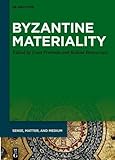Byzantine Materiality / ed. by Evan Freeman, Roland Betancourt.
Material type: TextSeries: Sense, Matter, and Medium : New Approaches to Medieval Literary and Material Culture ; 9Publisher: Berlin ; Boston : De Gruyter, [2024]Copyright date: 2024Description: 1 online resource (XVII, 299 p.)Content type:
TextSeries: Sense, Matter, and Medium : New Approaches to Medieval Literary and Material Culture ; 9Publisher: Berlin ; Boston : De Gruyter, [2024]Copyright date: 2024Description: 1 online resource (XVII, 299 p.)Content type: - 9783110799736
- 9783110981094
- 9783110980738
- 949.502
- online - DeGruyter
- Issued also in print.
| Item type | Current library | Call number | URL | Status | Notes | Barcode | |
|---|---|---|---|---|---|---|---|
 eBook
eBook
|
Biblioteca "Angelicum" Pont. Univ. S.Tommaso d'Aquino Nuvola online | online - DeGruyter (Browse shelf(Opens below)) | Online access | Not for loan (Accesso limitato) | Accesso per gli utenti autorizzati / Access for authorized users | (dgr)9783110980738 |
Frontmatter -- Acknowledgments -- Preface -- Contents -- Contributors -- List of Figures -- List of Abbreviations -- Introduction -- 1 The Materiality of Charis in Early Byzantium -- 2 The Animate Floor in Early Byzantium: Glass and Gold -- 3 Early Christian and Byzantine Bread Stamps: An Ecology of Matter and Form -- 4 Whence Agency? -- 5 Miniature Materials, Major Monuments: Concrete Connections and Concrete Histories -- 6 Materiality and Metonymy: Seeing the Eucharist through Stone and Glass in the Middle Byzantine Liturgy -- 7 Being Material, Material Being: Ivory and Ontology -- 8 The Place of Materiality in Byzantine Thought -- 9 Icon, Eucharist, Relic: Negotiating the Division of Sacred Matter in Byzantium -- 10 Icons, Relics, and the Substance of Things Half Seen -- Afterword -- Bibliography -- Index
restricted access online access with authorization star
http://purl.org/coar/access_right/c_16ec
This volume explores the power of matter and materials in the Eastern Roman Empire, also known as Byzantium. Recent attention to matter as dynamic and meaningful constitutes an emerging, interdisciplinary field of inquiry known as materiality, new materialism, or the material turn. Materials can be symbolic, but matter can also act on human subjects. This volume builds on these insights to consider the role of matter, materials, form, and embodied experiences in Byzantium. In many respects, Byzantine materiality represents a continuation of its Greco-Roman inheritance, which was also shared by neighboring peoples such as the Umayyads and Abbasids. But the Byzantines also developed their own, unique perspectives on matter and form, as with their parsing of the sacred materialities of icons, the Eucharist, and relics. Chapters in this volume consider the cultural meanings and functions of materials such as gold and ivory, the materiality of icons and relics, experiences of objects, as well as Byzantine philosophies of matter and form. Materiality takes center stage in Byzantine constructions of power, luxury, belief, and identity, which will be of interest to scholars and students of Byzantium and the wider medieval world.
Issued also in print.
Mode of access: Internet via World Wide Web.
In English.
Description based on online resource; title from PDF title page (publisher's Web site, viewed 20. Nov 2024)


